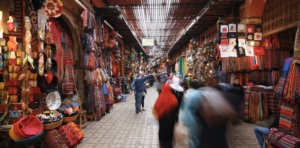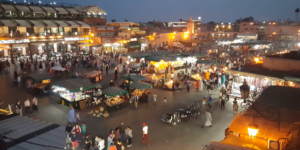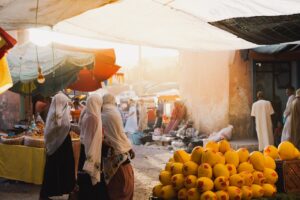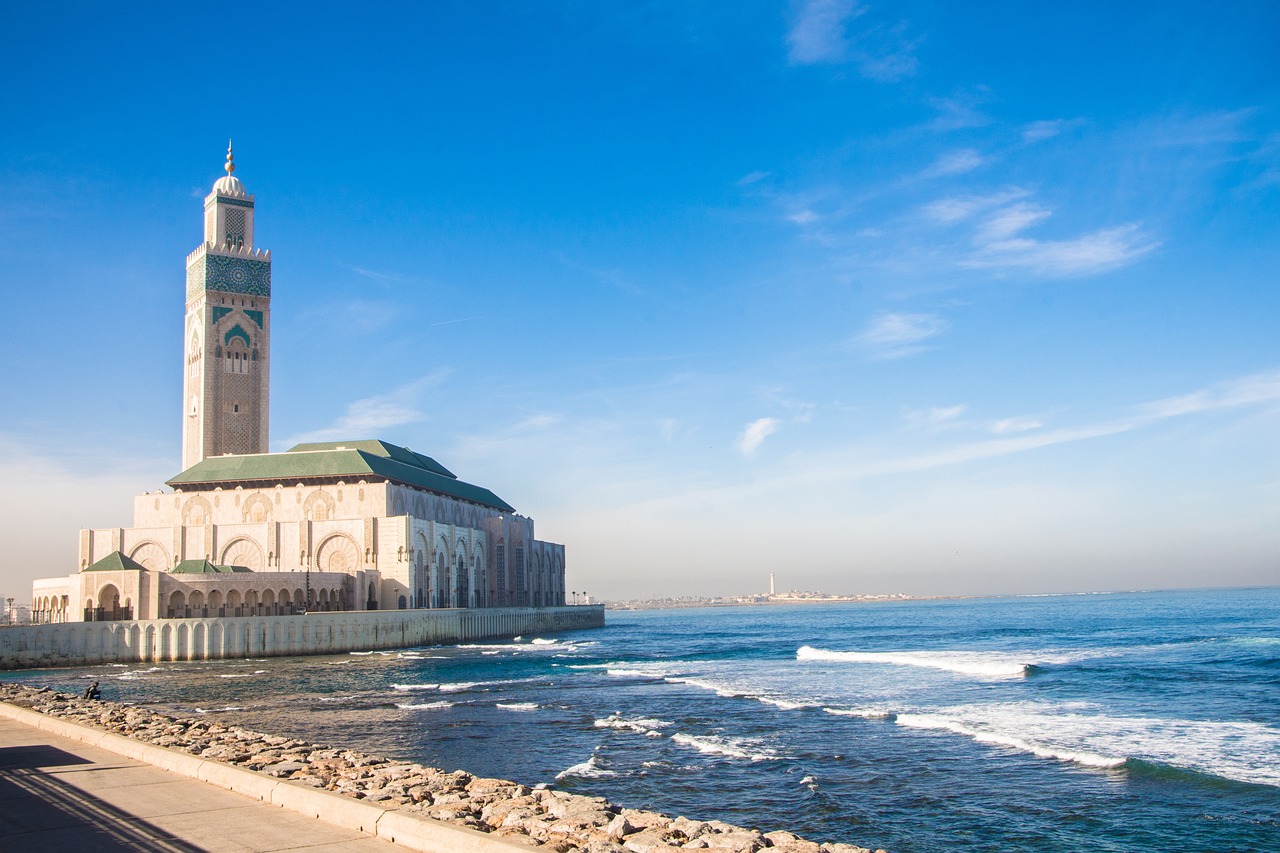Common Layover to Morocco, Casablanca

Casablanca- Your Gateway to Morocco
I was ecstatic as my plane landed at Casablanca Mohammed V International Airport (CMN). Casablanca, Morocco’s main city and commercial hub, has a distinct combination of ancient and contemporary history. The city originated as a modest Berber town and grew under the influence of numerous civilisations, notably the Phoenicians and Romans. It gradually grew into the busy metropolitan centre that it is today.
Casablanca is a fantastic stopover destination, offering a rich history, diversified culture, and contemporary adventures. Whether you fly with Royal Air Maroc or another carrier, the city makes an excellent layover. I personally utilised Skyscanner to get the best and cheapest ticket because it analyses all available alternatives and offers the lowest price.

Why Casablanca is a Common Layover Destination
Casablanca is strategically placed at the crossroads of Europe, Africa, and the Middle East, making it an important stopover destination. Airlines including Royal Air Maroc, Air France, and KLM frequently use CMN for connecting flights. It is a popular stop for travellers on their way to other Moroccan towns like as Marrakech or Fez, as well as long-haul flights to distant places.
Casablanca’s unique location as a port city has long historical origins. It has been a key commerce hub since the Portuguese era, which adds to its accessibility and prominence in worldwide travel.

What Makes Casablanca Unique for Travelers?
Casablanca has this amazing mix of modern and traditional Moroccan life, like the breathtaking Hassan II Mosque and the lively Old Medina. If you’ve got a few hours to spare, you should definitely check out this historical city. One cool thing about it is the Art Deco architecture, which really took off in the 1920s and 1930s.
This design style features sleek geometric shapes and man-made materials, and you can really see it all over the city. It was influenced by the French during the Protectorate era, which lasted from 1912 to 1956. Casablanca have a deep history.
Casablanca really stands out with its beach vibe, fascinating history, and stunning architecture, making it a super exciting spot for a layover compared to other Moroccan cities.
Arriving at CMN Airport (Mohammed V International)

Arriving to CMN went more smoothly than predicted, albeit it may become congested during peak hours. The airport is named for King Mohammed V, who led Morocco’s independence from French colonial control in 1956. After landing, follow the signs to customs and immigration.
Queues may be long, so having your boarding pass and passport ready will help speed up the procedure. The airport also has free Wi-Fi, allowing you to stay connected while waiting.
How to Get from Casablanca Airport to the City
Casablanca Mohammed V International Airport (CMN) has a bunch of ways to help you get to the city centre fast and hassle-free. Taking the train is the cheapest way to go; it runs regularly from the airport to Casa Port station in the city. It’s a chill ride with some awesome views of Casablanca.
Taxis are super easy to find at the airport if you want a hassle-free ride. A taxi to the city centre usually runs about 300 MAD, and it’s a solid option if you’re in a rush or dealing with a lot of bags.
Those with more time can arrange a private car or take a guided trip from the airport to visit Casablanca, especially if they have a brief delay. No matter what you like, getting from Casablanca airport to the city is easy and chill. Visit – Casatramway

Train Options from Casablanca Airport
Trains are one of the most convenient ways to go from Casablanca airport to the city. The station is located in the basement of Terminal 1, and frequent trains run to Casa Port station in the city centre. The one-way ticket costs 43 MAD and the travel takes around 45 minutes. It’s a comfortable and economical mode of transportation that provides stunning views of the city as you approach.
- Travel Tip: Keep an eye on your valuables, particularly if the train is busy.

Taking a Taxi: What You Need to Know
Taxis are easily accessible for individuals who want a faster, more direct route. A cab from Casablanca Airport to the city centre usually costs roughly 300 MAD. Make careful to negotiate the amount upfront or request that the driver utilise the meter. It is suggested that you have cash in dirhams for the fare.
- Travel Tip: Petit taxis (little red taxis) are utilised for short city rides, whereas grand taxis (bigger white taxis) are used for longer excursions such as airport transfers.

Alternative Transport: Private Cars and Tours
If you’ve got a quick layover in Casablanca, think about grabbing a private car or joining a guided tour. There are a lot of companies that offer custom layover tours that pick you up right at Casablanca Airport and take you to the city’s best sights quickly.
Airlines Flying to Casablanca

The Casablanca Mohammed V International Airport (CMN) is a major hub that links the Middle East, Africa, and Europe. Many of the world’s best companies fly to Casablanca, such as Royal Air Maroc, Air France, KLM, Lufthansa, and Qatar Airways. Its good position means that you can often find cheap flights with handy layover times.
Casablanca is a great place to fly to get to other Moroccan cities or foreign destinations, whether you’re travelling for work or pleasure. Use Skyscanner to find the best deals on flights. It reviews prices from many companies and booking sites to help you save money on your next trip.
Top Attractions to Explore During Your Layover
If you have a stay in Casablanca, there are a few places you should visit to get a feel for the city’s rich past and lively culture. You can see both old and new parts of Morocco. The beautiful Hassan II Mosque is partly built over the Atlantic Ocean, and the Old Medina has lots of cute streets.
Do not miss the stunning Art Deco buildings, the calm Boulevard La Corniche beach walk, or the busy souks where you can find one-of-a-kind items made in the area. Casablanca has something for everyone, whether you’re interested in history, art, or just taking in the vibe of the city.

Must-Visit: Hassan II Mosque

When you have time in Casablanca, you should visit the Hassan II Mosque. It is one of the biggest mosques in the world and was finished in 1993. The mosque, which is partly built over the Atlantic Ocean, represents both Morocco’s strong Islamic faith and its link to the sea. The beautiful design is a mix of Islamic and traditional Moroccan styles. The building’s 210-meter-tall (700-foot-tall) tower is the world’s largest.
Information on Tours: For 120 MAD each, a guide can show you around the mosque for 45 minutes. Make sure you dress properly. Men shouldn’t wear shorts and women should cover their shoulders and legs. See the review.
Travel Tip: Get there early to make sure you get on a guided tour, and don’t forget to bring a camera to take pictures of the beautiful tilework and detailed architectural features.
Art Deco District: The French Legacy


Casablanca is known for its distinctive Art Deco architecture, which can be seen throughout the city, particularly around Place Mohammed V. This beautiful combination of European and Moorish styles symbolises the city’s French colonial history. This combination is shown by key buildings such as the Wilaya (prefecture) and the Palace of Justice, which give Casablanca’s urban panorama a European touch. Read – Moroccan architecture.
Travel Tip: Explore the region surrounding Place Mohammed V to truly appreciate the Art Deco influence and how it complements traditional Moroccan decor.
Relax by the Atlantic Coastline: Boulevard La Corniche

After viewing the Hassan II Mosque, walk down Boulevard La Corniche for a pleasant promenade along the Atlantic Ocean. This popular coastal promenade connects the city with the sea, and you’ll see folks enjoying the vista, sunbathing, or strolling along the shore.

Where to Eat: Stop by one of the numerous beach cafés for a cup of mint tea (about 20 MAD) while admiring the stunning vista. It’s the ideal location for a relaxed holiday.
Travel Tip: If you have extra time, go to Ain Diab Beach, a popular destination for both residents and visitors.
The Charm of Old Medina

Wander around Casablanca’s Old Medina, one of the city’s oldest neighbourhoods, and step back in time. While smaller and less elaborate than those in Fez or Marrakech, the Old Medina has a lively and busy ambiance. You’ll discover small alleyways lined with classic souks where you can buy handmade leather products, aromatic spices, and more.
Travel Tip: Look for the mediaeval city walls around Sqala Bastion, which are among the few surviving structures from the Portuguese era.
Shopping and Souks: A Bargain Hunter’s Paradise

Explore the souks in Casablanca’s Old Medina for a real adventure. There are many wonderful things to find in these traditional markets, such as handmade goods, beautiful fabrics, and rare spices. It’s normal to trade, so don’t be afraid to do it. You’ll often get a good deal.
The Port: From Pirates to Global Trade

End your stopover by seeing Casablanca’s busy harbour. Originally a modest cove frequented by pirates and European traders, the port has developed to become one of Morocco’s busiest and most significant harbours. Today, it represents Casablanca’s power as a worldwide trade hub.
Travel Tip: The port area is an excellent spot to learn about Casablanca’s nautical heritage while watching ships arrive and go.
Where to Stay in Casablanca
Although my layover in Casablanca did not need an overnight stay, I couldn’t resist exploring the city’s accommodation alternatives. I used Skyscanner to book my accommodation at a low cost and even went to a couple places in person to check possibilities. In the end, I decided to book through Skyscanner, but this is what I learnt along the way:

Luxury Hotels- Experiencing Casablanca’s Opulence

The Boulevard de la Corniche is the place to be if you want to relax in style. Some of Casablanca’s most famous hotels are along this stretch of coast, which I got to see while I was window shopping.
The Four Seasons Hotel Casablanca stood out because of its sleek, modern rooms and great setting right on the beach. The mood of the hotel is the right mix of high-class and leisure. The Sofitel Casablanca Tour Blanche, which is right in the middle of the city, is another great choice. This hotel is near the Hassan II Mosque and the Old Medina, which makes it both convenient and stylish. It’s a great choice for a city break.
Travel Tip: Need a little extra money to spend on your trip? Get a room that has a view of the ocean. The view of the sunset over the ocean is amazing!
Mid-Range Options- Comfort Without Breaking the Bank

As long as you don’t want to spend a lot of money, you can still find comfortable hotels in the middle price band.
The Kenzi Tower Hotel is a great choice because it is right in the middle of the business area. It’s a great choice for people who want an easy and comfy stay because of its sleek design and beautiful views of the city. The Barceló Anfa Casablanca is another great choice. It’s famous for its rooftop pool, which is a great place to relax after a day of sightseeing.
Budget-Friendly Stays: Casablanca on a Shoestring

Casablanca is also highly welcoming to budget travellers. The city includes a multitude of hostels and guesthouses, especially near the Old Medina. Although I didn’t need to stay overnight, I spoke with a few travellers who praised Hostel Beirut for its welcoming atmosphere and handy location. It’s an excellent choice for individuals seeking economical but decent lodgings.
Travel Tip: If you want to stay within your budget, try lodging in the Maarif or Gauthier neighbourhoods. These regions provide a more local, genuine experience while being more cheap than beachside or city-center choices.
Unique Stays: Riads and Boutique Hotels

If you’re looking for a genuine Moroccan experience, staying in a riad is definitely a choice you won’t forget. Traditional Moroccan houses are designed around a cosy inner courtyard or garden, providing a serene escape right in the heart of the city.
You know, riads are pretty popular in places like Marrakech, but Casablanca has some cool hidden spots too. One of them is Riad Jnane Sherazade, and it’s a lovely little retreat just a short walk from the city’s lively centre.
What to Eat in Casablanca
The meal was undoubtedly one of the pleasures of my Casablanca stopover. The city’s cuisine combines traditional Moroccan flavours with cosmopolitan influences. Here’s some of what I experienced:
Traditional Moroccan Dishes

When you go to Casablanca, you have to try some traditional Moroccan food. I got to enjoy a lamb tagine that was cooked slowly with prunes and nuts. The right mix of sweet and savoury tastes made it memorable.
Couscous, which is often called Morocco’s national food, is another dish you should try. I was lucky to be in Casablanca on a Friday, because that’s when a lot of people there eat couscous as a typical family meal.
Travel Tip: To get a real feel for a place, look for places that are full of locals. La Sqala was a secret gem I found. It’s a cute place inside an old fortress that serves delicious traditional Moroccan food in a beautiful, historic setting.
Seafood Specialties

As a seaside city, Casablanca has an abundance of fresh fish. I couldn’t resist sampling the grilled sardines, a real local delicacy. They were properly prepared and served in a quaint small restaurant near the port.
For those looking for a more daring nibble, sea urchin is a unique delight to explore, particularly during the winter months when it is in season. It’s an event you won’t want to miss if you enjoy unique flavours.
Street Food Experience

In Casablanca, you can’t miss the street food at all costs. The bocadillo, a burger that shows the Spanish impact on the city, caught my eye right away. This is a great quick lunch because it has tuna, boiled eggs, olives, and harissa in it.
Msemen, a fluffy Moroccan pancake that can be served sweet or savoury, was another great find. The sweet version with honey was what I chose, and it was wonderful. I drank a glass of mint tea to wash it down. This is a traditional Moroccan drink that is as much about the routine as it is about the taste.
Travel Tip: You should try street food, but be careful. Locals eating at the same stands as the food sellers is usually a good sign that the food is fresh and of good quality.
Modern Moroccan Cuisine

There’s more to Casablanca than just classic food. The city has a booming modern food scene where cooks are making traditional Moroccan dishes in new and interesting ways. Blend was a place that stood out to me. People love this place because it combines Moroccan flavours with ingredients from around the world, giving familiar meals a new twist.
Café Culture

Because Casablanca used to be a French colony, the city’s café culture is still going strong. A nous nous is a drink that is made with half coffee and half milk. I had a great afternoon sipping one at a pavement café and watching people walk by. Some of the best places to do this are in the middle of the city, at Café de France.
Travel Tip: You should try Moroccan mint tea before you leave Casablanca. It’s a sign of friendship and is usually served very sweet, but you can ask for less sugar if you’d rather have something less sweet. Read – Top Restaurants in Casablanca on Tripadvisor
How to Maximize Your Time on a Short Layover
If you only have a short time to kill in Casablanca, there are still lots of things you can do to pass the time. This guide will help you see the city without worrying about missing your flight, no matter how long you have.

Plan for a 4-hour layover in Casablanca
You only have 4 hours, so you should keep things easy and close to the airport. Here is a quick plan that will let you see a lot of Casablanca without feeling rushed:
Pay a visit to the Hassan II Mosque
- One of the biggest mosques in the world, this beautiful one is a must-see. It’s only 30 minutes from the airport, which makes it a great place to start. You can enjoy the outside and ocean views even if you don’t have time for a full tour. Check to see if there is a quick tour available if you want to go inside—times can be limited.
Walk along Boulevard La Corniche for 1 hour
- A beautiful beach walk called Boulevard La Corniche is just a 10-minute cab ride from the mosque. Take a slow walk along the Atlantic Ocean in this area. You can take pictures, enjoy the view, and feel the salty air. If you don’t have much time, you can stop by one of the cafés by the water for a coffee and watch the waves.
Go back to the airport (1.5-2 hours)
- Give yourself at least two hours to get back to the airport and go through security. When it’s rush hour in Casablanca, traffic can be unexpected, so give yourself a little extra time to make sure you don’t miss your trip.

Plan for an 8-hour layover in Casablanca
With 8 hours, you have a little more freedom to see some of the city’s best sights. This plan takes you to both old and new parts of Casablanca:
Hassan II Mosque Tour with a Guide (1 hour)
- Start your day with a walk of the Hassan II Mosque with a guide. This will help you learn more about its history, building, and cultural importance. The mosque gives walks in a number of languages, so check ahead of time to see what’s available. This is a famous spot in Casablanca that is well worth the time.
Walk along the beach on Boulevard La Corniche for 1 hour
- Take a cab to Boulevard La Corniche after seeing the mosque for a nice walk along the water. You can even stop at one of the beach clubs for a quick snack or coffee with a view of the ocean if you feel like it.
Spend 1.5 to 2 hours exploring the Old Medina.
- Next, go to the Old Medina to get to the heart of Casablanca. There are lots of small streets, local markets, and bright colours in this ancient area. Take your time to walk around and find handmade goods, spices, and food from the street. For some interesting buildings and coffee shops in the area, you can also stop by Mohammed V Square.
Travel Tip: If you want to try something new, go for street food. It could be grilled sardines, a bocadillo burger, or newly made Msemen (Moroccan pancakes). These traditional snacks taste great in the Old Medina.
Eat lunch at a nearby restaurant (1 hour)
- If you get hungry after wandering, you can get lunch at one of the nearby places. In a historic setting, La Sqala serves traditional Moroccan food. For something more modern, try Blend, which combines Moroccan flavours with those from around the world.
Go back to the airport (2 hours)
- Leave the Old Medina at least two hours before your flight to account for possible delays and to get through security. It’s better to be safe than sorry when it comes to traffic in Casablanca.

Additional Tips for Maximizing Your Layover in Casablanca
- Transportation: Taxis are the fastest way to get around Casablanca, but make sure you agree on the price before you get in, or make them use the meter. Instead, use ride-hailing apps like Careem or Uber (if they’re available) to get a more accurate quote on the price.
- Language: The most common language in Casablanca is Arabic, but many people also know French. In tourist spots, people speak English, but it’s always helpful to know a few simple Arabic or French words and sentences to get around.
- Security and Time Management: When planning what to do during your break, you should always include security and check-in times. It’s best to have extra time two hours before your trip, especially if you’re flying internationally.
Following this guide will help you see, eat, and do some of the best things Casablanca has to offer while still making it back to the airport in time for your next trip. Read – Morocco Travel Advisory.
Essential Travel Tips for Your Casablanca Layover

Understanding Local Customs and Etiquette.
Casablanca is a friendly city, but like with any location, respecting local customs and etiquette may make your trip much more pleasurable. Here are a few things to remember:
- Modesty is Essential: Morocco is largely Muslim, and modest behaviour and clothes are highly prized, especially while visiting holy places such as mosques. When entering places of religion, dress conservatively, with your shoulders and knees covered. A scarf to cover your head may be useful for ladies, yet it is not always necessary.
- Respect for Religion and Traditions: When visiting mosques, such as the Hassan II Mosque, remember that they are places of prayer and meditation. Be mindful of the environment, be quiet, and avoid taking photographs in sensitive places unless authorised.
- Politeness and Patience: In Moroccan society, politeness is highly valued. When engaging with locals, especially at markets or stores, be patient and pleasant. A simple “Salam Alaikum” (peace be with you) may go a long way towards establishing relationships with others.
-
Affordable Eco-Friendly Tips for Traveling – Sustainable Vacation
Travel Tip: Bargaining is prevalent in Moroccan marketplaces, but always treat it with respect. When negotiating rates, be courteous but firm; it is viewed as a nice and respectful transaction rather than an aggressive one. If you’re hesitant, just smile and walk away if the price doesn’t feel right; they’ll most likely offer a better bargain.

Other Essential Travel Tips
- Language: While Arabic and French are the most often spoken languages in Casablanca, many individuals, especially in tourist areas, can speak in English. However, knowing a few simple Arabic words (such as “Shukran” meaning “thank you“) will help you communicate more effectively with locals.
- Tipping: Tipping is popular in Casablanca, although not necessarily required. Waitstaff at restaurants are often given a small tip (5-10% of the bill), as do taxi drivers and hotel staff. A few dirhams may go a long way towards expressing gratitude for good service.
- Safety & Security: Casablanca is typically secure for tourists, although as with any big city, it is advisable to exercise caution, particularly in congested areas like as the Old Medina. Keep an eye on your possessions and avoid exhibiting valuables such as cameras or jewellery on public streets.
- Time management: Be aware of the city’s traffic, especially if you have a brief stopover. Allow additional time to return to the airport, since delays may occur due to heavy traffic. Casablanca is a lively city, so it’s always a good idea to arrange your return with caution.
- Weather: Casablanca has a warm climate, however temperatures fluctuate throughout the year. If you’re coming in the summer, dress light and breathable, but remember to carry a scarf or jumper for chilly evenings along the seaside. For more knowledge – Visit Morocco Official Tourism Site
Safety and Practical Considerations

Time Management: Getting Back to the Airport
It’s important to keep track of time when you have a break in Casablanca, especially when it’s time to go back to Mohammed V International Airport (CMN). It can get very crowded at the airport, especially during busy times and high journey times, so make sure you plan ahead.
- You should get there at least two hours before your flight to give time for security checks, check-in, and possible delays. If you’re travelling abroad or during rush hour, this delay is very important.
Travel tip: If you need to get back to the airport quickly and don’t have much time, the train is faster and cheaper than a car. There are several ways to get from the Casa Voyageurs train stop to the airport. The trip takes only thirty minutes.
Some more useful tips for a stress-free layover
- Keep your things close: Even though Casablanca is generally safe, watch out for your things, especially in busy places like the Old Medina. You can keep your valuables safe with a money belt or a shoulder bag with a lock.
- Find Out About the Local Money: The Moroccan dirham (MAD) is the local money. While many shops and restaurants in tourist areas take cards, it’s still a good idea to bring cash with you for small purchases or food you buy on the street. There are a lot of ATMs in the city.
- Things to Know About the Weather: The weather in Casablanca is mild, but it can get cooler at night, especially near the coast. Bring a light jacket or jumper with you at all times, especially if you’re going to be near the water, like at Boulevard La Corniche.

Casablanca really is a city of contrasts—it’s where modern life blends with tradition, and the Atlantic Ocean connects with ancient history. From the stunning Hassan II Mosque to the lively, bustling streets of the Old Medina, this city has a mix of experiences that will stick with you even after your layover is over.
If you happen to be in Casablanca, make sure to soak in its unique culture, delicious flavours, and beautiful views. Whether you’re taking a leisurely walk by the coast or exploring the vibrant heart of the Medina, you’re definitely going to come away with some amazing memories.
I’m really curious to know what your favourite moments in Casablanca are! I’d love to hear what you think in the comments below! And if you have any questions while you’re planning your layover adventure, just reach out—I’m here to help!
Read My Other Blogs –
Why Chefchaouen Blue City Morocco is Called the “Blue City”
14 Top Things to Do in Tangier Itinerary – Morocco Africa
13 Things to Do in Cappadocia Turkey
Frequently Asked Questions (FAQ) About Layovers in Morocco

Q: Where do most people fly into Morocco?
A: Most international travellers fly into Mohammed V International Airport (CMN) in Casablanca. The busiest airport in Morocco. Also, the primary entry point for long-haul flights from Europe, North America, and beyond.
Q: What to do in Morocco during a layover?
A: If you have a layover in Casablanca, there are plenty of things to do, even with limited time. You can visit iconic landmarks like the Hassan II Mosque, stroll along Boulevard La Corniche, or explore the charming Old Medina. Try local cuisine or take in the stunning Art Deco architecture if time allows.
Q: What is the easiest airport to fly into Morocco?
A: Mohammed V International Airport (CMN) in Casablanca is the most well-connected and easiest airport to fly into. It serves as the central hub for international flights and offers convenient transport options to the city.
Q: Can you leave the airport during a layover in Morocco?
A: If you have enough time during your layover, you can leave the airport to explore nearby attractions. For shorter layovers (4-8 hours), visiting the Hassan II Mosque and the Old Medina in Casablanca is highly recommended. Make sure to account for travel time back to the airport and security check-in.
Q: Is it easy to travel between cities in Morocco?
A: Yes, Morocco has a good network of trains, buses, and taxis that make it easy to travel between cities. For example, trains connect Casablanca to Rabat, Marrakech, and Fes efficiently. Tr trains are the most reliable option if you’re planning a day trip.
Q: What is the most common airport in Morocco?
A: The most common airport is Mohammed V International Airport (CMN) in Casablanca. It handles the majority of international flights and serves as the main gateway for travellers entering the country.
Q: Why is it so cheap to fly to Morocco?
A: Flights to Morocco can be relatively inexpensive due to budget airlines that operate from major European cities. Strong competition among airlines, and seasonal promotions makes it more affordable. Morocco’s strategic location between Europe and Africa also allows for shorter flight distances. Which helps keep fares lower.
Q: What is the best city to visit in Morocco for the first time?
A: For first-time visitors, Marrakech is often considered the best city to visit. Known for its rich culture, vibrant souks, and historical landmarks. It offers a great introduction to Morocco’s unique charm. Casablanca is also a popular choice, especially for those on short layovers.
Q: How many days in Morocco is enough?
A: A minimum of 7 to 10 days is recommended to get a good feel for Morocco. This allows enough time to explore major cities like Marrakech, Fes, Casablanca, and Rabat. Even venture into the Sahara Desert or the Atlas Mountains for a more immersive experience.
Q: What is the safest city to visit in Morocco?
A: Rabat, the capital of Morocco, is often considered one of the safest cities to visit. It has a calm atmosphere and less hustle compared to other major cities. It is home to important historical and political landmarks. However, cities like Marrakech and Fes are generally safe for tourists. With common-sense precautions.
Read My other blogs and Learn more about Morocco.



